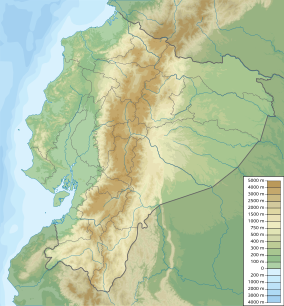| Llanganates National Park | |
|---|---|
 High elevation páramo at Llanganates NP | |
| Location | Ecuador Cotopaxi Province, Napo Province, Pastaza Province and Tungurahua Province. |
| Coordinates | 1°8′0″S 78°14′0″W / 1.13333°S 78.23333°W |
| Area | 219,707 ha |
| Established | January 18, 1996 |
Llanganates National Park (Spanish: Parque Nacional Llanganates) is a protected area in Ecuador situated in the Cotopaxi Province, Napo Province, Pastaza Province and Tungurahua Province. Located within the park is Cerro Hermoso ("beautiful mountain"), a 4,570 meters (14,990 ft) high peak that is a popular hiking destination. The park is famous for the Treasure of the Llanganatis.
The park can be accessed from a number of directions, but visitors usually come through towns such as Salcedo, Patate, Pillaro, Baños, and Rio Verde.
YouTube Encyclopedic
-
1/3Views:4 63815 6514 837
-
Human Resonance: Llanganates Pyramids
-
Parque Nacional LLANGANATES Ecuador ¿COMO LLEGAR? + Pesca de TRUCHAS en la Sierra /Laguna PISAYAMBO
-
Las Pirámides LLangantes
Transcription
Ecology
The park is divided into two ecological zones, the western zone and the eastern zone. The western zone is located in the Andean páramo, high above the eastern zone, containing a deserted landscape of mountainous peaks and high valleys. The area is populated mainly by South American camelids like vicuñas, llamas and alpacas.
The eastern zone is located on the eastern flanks of the Andes, with montane forests characterized by a rich diversity of plants and animals among the twisted forests of the upper Amazon. This area is highly unreachable, and is usually traversed only by foot. The large number of rivers, emptying out the Andes also makes this area difficult to cross. In recent years, several new species of plants have been discovered here, including several species of rare Andean Magnolia.[1][2][3][4]
Exploration
In 2013, explorers from Ecuador, Britain, France, and America discovered and unearthed a 260 ft tall by 260 ft wide structure, made up of hundreds of two-ton stone blocks, and believe there could be more, similar constructions over an area of about a square mile. The area is 20 miles from the town of Baños but the trek takes around eight hours through swampy and mountainous jungle. The area of discovery is at an altitude of 8,500 ft above sea level and in cloud forest.[5]
References
- ^ Vázquez-García, J.-Antonio; Neill, David A.; Asanza, Mercedes (2015-06-22). "Magnolia vargasiana (Magnoliaceae), a new Andean species and a key to Ecuadorian species of subsection Talauma, with notes on its pollination biology". Phytotaxa. 217 (1): 26. doi:10.11646/phytotaxa.217.1.2. ISSN 1179-3163.
- ^ OROZCO, CLARA INÉS; PÉREZ, ÁLVARO J.; ROMOLEROUX, KATYA; ALDANA, JOSÉ MURILLO (2017-06-30). "The discovery of a new species of Brunellia (Brunelliaceae) with ephemeral petals from Llanganates National Park, Ecuador". Phytotaxa. 311 (3): 263. doi:10.11646/phytotaxa.311.3.6. ISSN 1179-3163.
- ^ Vázquez-García, J. Antonio; Neill, David A.; Recalde, Fausto; Asanza, Mercedez (2016-09-08). "Magnolia llanganatensis (Subsect. Talauma, Magnoliaceae), una especie nueva de Tungurahua y clave para las especies de Magnolia de Ecuador". Botanical Sciences. 94 (3): 593. doi:10.17129/botsci.435. ISSN 2007-4476.
- ^ VÁZQUEZ-GARCÍA, J.-ANTONIO; NEILL, DAVID A.; SHALISKO, VIACHESLAV; ARROYO, FRANK; MERINO-SANTI, R. EFRÉN (2018-05-04). "Magnolia mercedesiarum (subsect. Talauma, Magnoliaceae): a new Andean species from northern Ecuador, with insights into its potential distribution". Phytotaxa. 348 (4): 254. doi:10.11646/phytotaxa.348.4.2. ISSN 1179-3163.
- ^ Copping, Jasper (15 Dec 2013). "Explorers hot on the trail of Atahualpa and the Treasure of the Llanganates". The Telegraph. Retrieved 19 June 2014.
External links
- www.murcielagoblanco.com / List of mammals in the Llanganates National Park[permanent dead link] (Spanish)
- www.birdlife.org / List of birds in the Llanganates National Park (Spanish / English)
- / Attractions of the Llanganates (Spanish)

